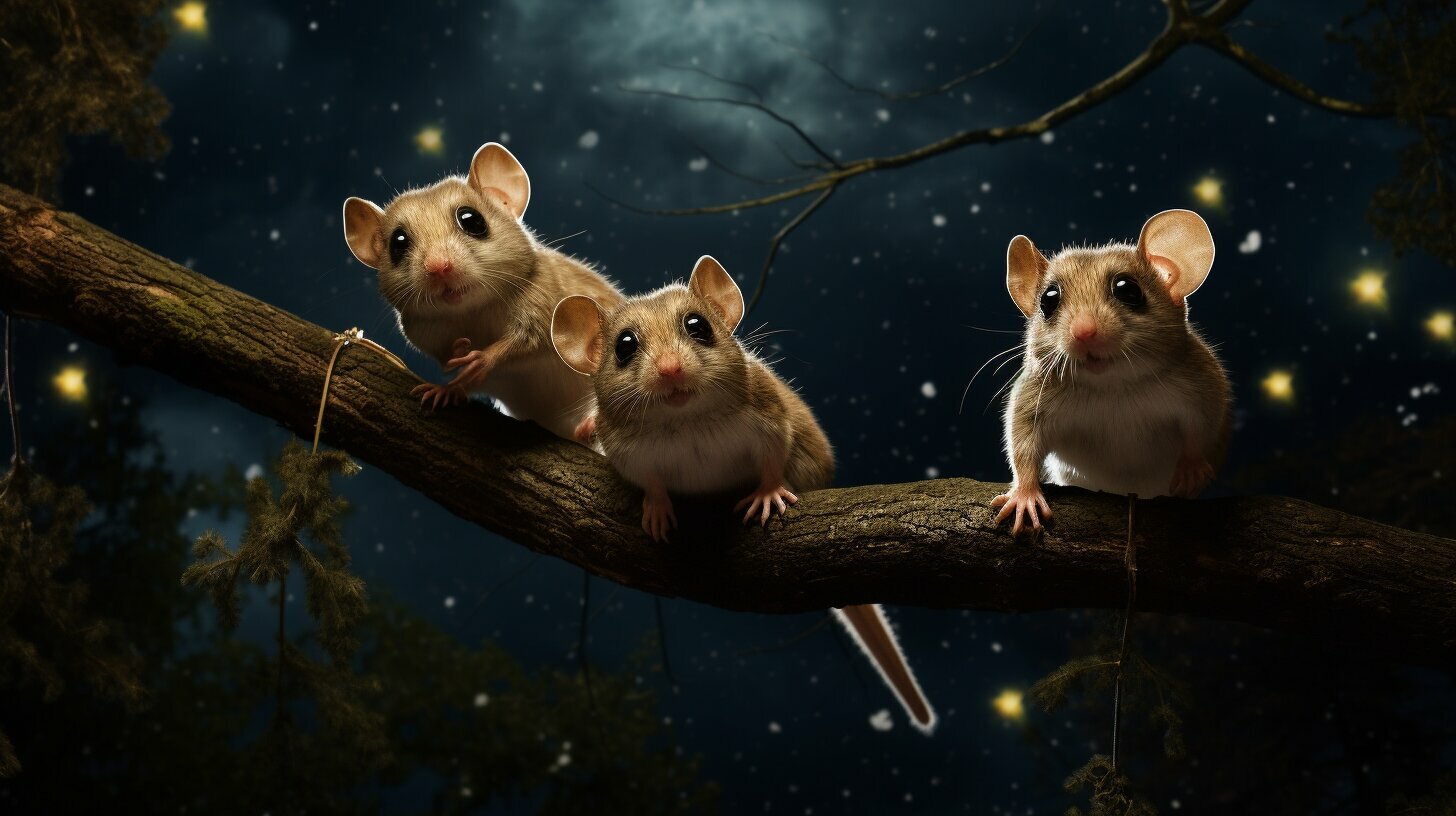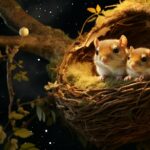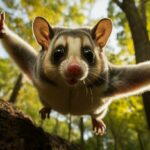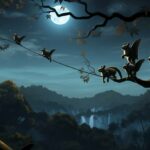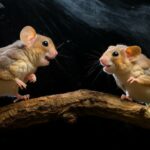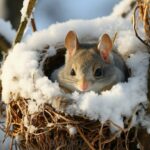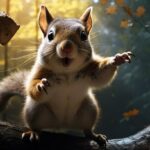Flying squirrels are captivating creatures that exhibit intriguing nocturnal behavior. These small mammals are known for their ability to glide through the air, making them a fascinating subject of study. In this article, we will delve into the world of flying squirrel nocturnal behavior, uncovering their habits, adaptations, and the important role they play in maintaining a balanced ecosystem.
Key Takeaways:
- Flying squirrels are nocturnal mammals that adapt their activity to changes in environmental temperatures and length of darkness.
- They have excellent night vision thanks to their large eyes and a high density of rods in their retinas.
- Flying squirrels do not hibernate but enter a state of torpor during winter to conserve energy.
- They live in various habitats, including trees, rock crevices, and attics, and prefer to stay off the ground when foraging.
- Their diet consists of nuts, seeds, mushrooms, and fruit, and they are known for their ability to glide using a fleshy membrane called the patagium.
Understanding the Lifestyle of Flying Squirrels at Night
Flying squirrels are primarily active during the night, making their behavior unique among squirrel species. These nocturnal mammals have adapted their lifestyle to thrive in the dark. They are known to adjust their activity levels based on environmental factors such as temperature and the length of darkness.
During the winter months, flying squirrels limit their foraging trips to a few hours, conserving energy as they rely on stored food and hunker down in their nests. However, in the warmer seasons, they become active shortly after sunset, embarking on night-time adventures until just before dawn.
One of the most remarkable traits of flying squirrels is their exceptional night vision. With their large eyes and a high density of rods in their retinas, these creatures can see remarkably well in low-light conditions. This visual adaptation allows them to navigate their surroundings, find food, and evade potential predators during their nightly expeditions.
Living in a variety of habitats, including trees, rock crevices, and even attics, flying squirrels prefer to stay off the ground when foraging. Their diet consists of nuts, seeds, mushrooms, and fruit. Using their patagium, a fleshy membrane that stretches from their wrists to their ankles, they are capable of gliding through the air, enabling them to move swiftly and efficiently in search of food.
| Notable Facts About Flying Squirrels: |
|---|
| Flying squirrels do not hibernate but enter a state of torpor during winter to conserve energy. |
| In the wild, they have a lifespan of less than four years and face threats from predators such as owls, hawks, martens, weasels, coyotes, and domestic cats. |
| Some populations of flying squirrels, like the North Carolina and West Virginia northern flying squirrels, are endangered due to habitat destruction and pollution. |
| These fascinating creatures play an important role in spreading spores of fungi and contributing to a thriving ecosystem. |
From their intriguing behavior to their vital place in nature, flying squirrels have captivated the curiosity of researchers and nature enthusiasts alike. By exploring their nocturnal lifestyle, we can gain a deeper appreciation for the unique adaptations and ecological significance of these extraordinary creatures.
Adaptations for Nighttime Foraging
To navigate and locate food in the darkness, flying squirrels possess specialized adaptations. These nocturnal mammals have developed keen senses and physical features that enable them to thrive in low-light conditions. Their large eyes, for instance, are highly efficient at gathering available light, allowing them to see clearly at night. The retinas of flying squirrels contain a high density of rods, which are light-sensitive cells that enhance their night vision. This adaptation enables them to spot and track their prey, such as insects, fruits, nuts, and seeds, even in the dimmest of light.
In addition to their exceptional vision, flying squirrels possess acute hearing and an extraordinary sense of touch. Their large ears are finely tuned to pick up the slightest rustles and sounds, alerting them to potential threats or the presence of food nearby. Moreover, their vibrissae, the specialized hairs found on their face and limbs, serve as sensory organs. These whiskers are sensitive to delicate vibrations in the air and can help flying squirrels detect the movement of nearby objects, facilitating their precise and agile movements through the night sky.
Another remarkable adaptation of flying squirrels is their ability to glide. They have a specialized membrane of skin known as the patagium, which stretches from their wrists to their ankles. By extending their limbs and spreading their patagium, flying squirrels can glide through the air for impressive distances, smoothly navigating from tree to tree in search of food. This gliding ability not only allows them to access otherwise unreachable food sources but also offers protection from ground predators.
| Adaptations for Nighttime Foraging | Description |
|---|---|
| Large Eyes | Provide excellent night vision with a high density of rods. |
| Acute Hearing | Enable detection of sounds, rustles, and potential dangers. |
| Vibrissae | Sensitive hairs that help detect movement in the air and aid in precise movements. |
| Patagium | A fleshy membrane that allows gliding through the air for long distances. |
These adaptations collectively equip flying squirrels with the tools they need to successfully forage for food during the night. By utilizing their exceptional vision, hearing, and touch, as well as their ability to glide effortlessly, these fascinating creatures have mastered the art of nighttime survival.
The Role of Vision in Flying Squirrel Nocturnal Behavior
Flying squirrels have remarkable vision that enables them to hunt and move efficiently at night. Their large eyes and high density of rods in their retinas allow them to see well in low-light conditions, giving them a distinct advantage in their nocturnal activities.
These adaptable rodents adjust their behavior based on changes in environmental temperatures and the length of darkness. During the winter months, flying squirrels limit their foraging to just a few hours, conserving energy by entering a state of torpor. In warmer months, they become active shortly after sunset, continuing their activities until just before dawn.
When foraging, flying squirrels prefer to stay off the ground and instead glide through the air using a fleshy membrane called the patagium. This enables them to navigate between trees and avoid potential predators on the ground. Their diet consists of nuts, seeds, mushrooms, and fruit, making them important contributors to the dispersion of spores and the maintenance of a thriving ecosystem.
| Predators of Flying Squirrels | Lifespan of Flying Squirrels | Conservation Status |
|---|---|---|
| Owls | Less than four years in the wild | Threatened and endangered |
| Hawks | Due to habitat destruction and pollution | |
| Martens | ||
| Weasels | ||
| Coyotes | ||
| Domestic cats |
Flying squirrels are an integral part of many ecosystems, contributing to the dispersal of fungi spores and helping to maintain a balanced environment. However, some populations, such as the North Carolina and West Virginia northern flying squirrels, are threatened and listed as endangered due to habitat destruction and pollution. Conservation efforts are crucial to ensure the survival of these fascinating creatures and their important role in our natural world.
Sleep Patterns and Torpor
Flying squirrels have unique sleep patterns and enter a state of torpor to conserve energy during the night. As nocturnal mammals, they are most active when darkness falls, taking advantage of the cover it provides. During winter, flying squirrels reduce their activity levels to cope with the harsh conditions. They spend more time in their nests, emerging briefly for short periods to forage. This adaptation allows them to minimize energy expenditure and withstand the colder temperatures.
When the warmer months arrive, flying squirrels become more active, extending their foraging time from just after sunset until just before dawn. They are remarkably adapted to life in the dark, with their large eyes and high density of rod cells in their retinas, enabling excellent night vision. This visual acuity allows them to navigate through the treetops and spot potential food sources even in low-light conditions.
Unlike hibernation, which involves a prolonged deep sleep, flying squirrels enter a state of torpor during winter nights. Torpor is a temporary decrease in metabolic rate and body temperature, enabling these small mammals to conserve energy. While in torpor, flying squirrels can reduce their body temperature, heart rate, and breathing rate, allowing them to survive on limited food sources during the colder months.
| Sleep Patterns | Torpor |
|---|---|
| Unique sleep patterns adapted to nocturnal lifestyle | State of reduced metabolic rate and body temperature |
| Most active during nighttime hours, minimizing exposure to predators | Enables energy conservation during winter months |
| Adapted for foraging and movement in low-light conditions | Allows survival on limited food sources |
In conclusion, flying squirrels exhibit fascinating sleep patterns and utilize torpor to adapt to their nocturnal lifestyle. These adaptations enable them to thrive in their natural habitat, balancing their energy requirements with the challenges of navigating in the dark. By understanding the intricacies of flying squirrel behavior during darkness, we gain valuable insights into the unique and enigmatic world of these remarkable creatures.
Habitat and Foraging Preferences
Flying squirrels can be found in a variety of habitats and have specific preferences when it comes to foraging. These nocturnal creatures are skilled climbers and are often found in forests with dense vegetation, as well as wooded areas near water sources. They make their nests in tree cavities, rock crevices, and even human-made structures such as attics. Their ability to glide from tree to tree, using the patagium, a fleshy membrane that spans from their wrists to their ankles, allows them to navigate their habitat with ease.
When it comes to foraging, flying squirrels have a diverse diet that includes nuts, seeds, mushrooms, and fruit. They are particularly fond of acorns, hickory nuts, and beechnuts. These resourceful creatures have been known to store food for the winter by burying nuts and seeds in multiple locations. They prefer to stay off the ground when foraging and will often rely on their gliding ability to move from tree to tree in search of food.
To give you a better idea of their foraging preferences, here is a table showcasing some of the foods commonly consumed by flying squirrels:
| Food | Description |
|---|---|
| Nuts (e.g., acorns, hickory nuts, beechnuts) | Rich in fats and proteins, these nuts provide a valuable energy source for flying squirrels. |
| Seeds (e.g., pine seeds, sunflower seeds) | Seeds are a staple in the flying squirrel diet, offering essential nutrients. |
| Mushrooms | Flying squirrels are skilled at locating and consuming various mushroom species that grow in their habitat. |
| Fruit (e.g., apples, berries) | Flying squirrels enjoy the sweet taste of fruit and will opportunistically feed on available options. |
By incorporating these food sources into their diet, flying squirrels are able to maintain their energy levels and thrive in their preferred habitats. Their ability to traverse their habitat through gliding, combined with their specific foraging preferences, make them unique and fascinating creatures of the night.
Conservation and Importance in Ecosystems
Flying squirrels play a vital role in ecosystems and face threats that have led to endangered status in some populations. These charismatic creatures contribute to the health and balance of their habitats by aiding in the dispersal of seeds and spores. As they forage for nuts, seeds, mushrooms, and fruit, they unintentionally assist in spreading these important components of plant reproduction. This symbiotic relationship between flying squirrels and plants helps to maintain diverse and thriving ecosystems.
However, the conservation status of flying squirrels is a cause for concern. Habitat destruction and pollution have severely impacted their populations, particularly in areas such as North Carolina and West Virginia, where the northern flying squirrel is listed as endangered. This highlights the urgent need to protect their habitats and address the issues that threaten their survival.
To fully understand the significance of flying squirrels in ecosystems, it is crucial to recognize their role as prey for various predators. Owls, hawks, martens, weasels, coyotes, and domestic cats all rely on flying squirrels as a food source. The delicate balance between predator and prey helps to regulate population sizes and maintain a stable food chain. The decline in flying squirrel populations can have far-reaching effects on the entire ecosystem, underscoring the importance of their preservation.
Threatened Flying Squirrel Populations
Two specific populations of flying squirrels, the North Carolina and West Virginia northern flying squirrels, are particularly threatened. They are faced with habitat loss due to deforestation and urbanization, resulting in the destruction of their natural homes. Pollution from industrial activities further compounds the challenges they face.
To safeguard these endangered populations, conservation efforts are crucial. The protection and restoration of their habitats, as well as the implementation of measures to reduce pollution and human disturbance, are essential steps toward their conservation. Conservation organizations and initiatives are working tirelessly to raise awareness, conduct research, and develop strategies to ensure the survival of these remarkable creatures.
| Threats to Flying Squirrels | Conservation Actions |
|---|---|
| Habitat destruction due to deforestation and urbanization | Protection and restoration of habitats |
| Pollution from industrial activities | Implementation of measures to reduce pollution |
| Predation by owls, hawks, martens, weasels, coyotes, and domestic cats | Preservation of predator-prey relationships |
By recognizing the importance of flying squirrels in ecosystems and taking action to protect them, we can ensure that these captivating animals continue to grace our skies and contribute to the delicate balance of nature.
The Enigmatic World of Flying Squirrel Nocturnal Behavior
The nocturnal behavior of flying squirrels is a fascinating phenomenon that showcases the adaptability and unique characteristics of these extraordinary creatures. Unlike their diurnal counterparts, flying squirrels thrive under the cover of darkness, making their presence known in the moonlit shadows.
With their large, captivating eyes and a retinal composition designed for low-light conditions, flying squirrels possess a heightened sense of vision that allows them to navigate the night with ease. Their keen eyesight, coupled with the ability to glide effortlessly through the air using their patagium, creates a truly mesmerizing sight as they glide from tree to tree in search of sustenance.
As the sun sets and darkness envelops the landscape, the nocturnal world of flying squirrels comes alive. These agile creatures emerge from their nests, venturing out into the night to forage for nuts, seeds, mushrooms, and fruit. Their diet plays a vital role in the ecosystem, as they unknowingly become agents for spreading spores of fungi.
While winter brings a period of reduced activity for flying squirrels, they demonstrate remarkable resilience and adaptability to the changing seasons. Rather than hibernating, they enter a state of torpor, conserving energy as they wait for the arrival of warmer months. It is during these times that their survival skills are truly put to the test, as they face the challenges of finding food in the barren winter landscape.
Unfortunately, some populations of flying squirrels find themselves facing an uncertain future. Habitat destruction and pollution have resulted in the decline of certain species, including the North Carolina and West Virginia northern flying squirrels, which are listed as endangered. This serves as a stark reminder of the delicate balance required to maintain a thriving ecosystem and the importance of preserving the habitats these remarkable creatures call home.
How Does Nocturnal Behavior Play a Role in Flying Squirrel Migration?
Nocturnal behavior plays a significant role in uncovering flying squirrel migration mysteries. These mysterious creatures are known for their ability to glide through the night sky, traveling long distances to find food and suitable habitats. By studying their nocturnal behavior patterns, scientists can gain insights into their migration routes, breeding habits, and overall population dynamics. Understanding these aspects is crucial for their conservation and ensuring their long-term survival in the wild. So, let’s delve deeper into the captivating world of flying squirrel migration and the secrets it holds.
FAQ
Q: Are flying squirrels really nocturnal?
A: Yes, flying squirrels are nocturnal mammals. They sleep during the day and are active at night.
Q: What do flying squirrels eat?
A: Flying squirrels have a varied diet that includes nuts, seeds, mushrooms, and fruit.
Q: How do flying squirrels see in the dark?
A: Flying squirrels have large eyes with a high density of rods, allowing them to see well in low-light conditions.
Q: Do flying squirrels hibernate?
A: No, flying squirrels do not hibernate. They enter a state of torpor during winter to conserve energy.
Q: Where do flying squirrels live?
A: Flying squirrels live in various habitats, including trees, rock crevices, and even attics.
Q: How long do flying squirrels live?
A: Flying squirrels have a lifespan of less than four years in the wild.
Q: What are the threats to flying squirrels?
A: Flying squirrels are preyed upon by owls, hawks, martens, weasels, coyotes, and domestic cats. Some populations are also threatened by habitat destruction and pollution.
Q: Do flying squirrels have any ecological importance?
A: Yes, flying squirrels may have important roles in spreading spores of fungi and helping maintain a thriving ecosystem.

